Park roses: varieties and rules of care
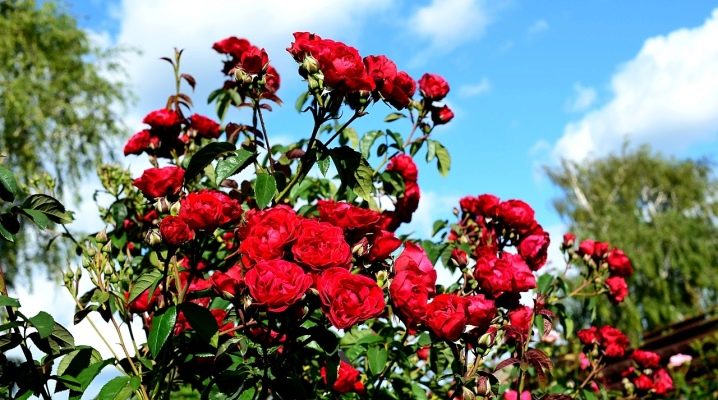
Park roses are truly amazing plants that attract the eye with their subtle beauty and restraint. Roses gained their greatest popularity in the UK and then quickly spread throughout the world. Today, they often decorate not only park ensembles, but also private summer cottages, country houses, garden and winter corners.
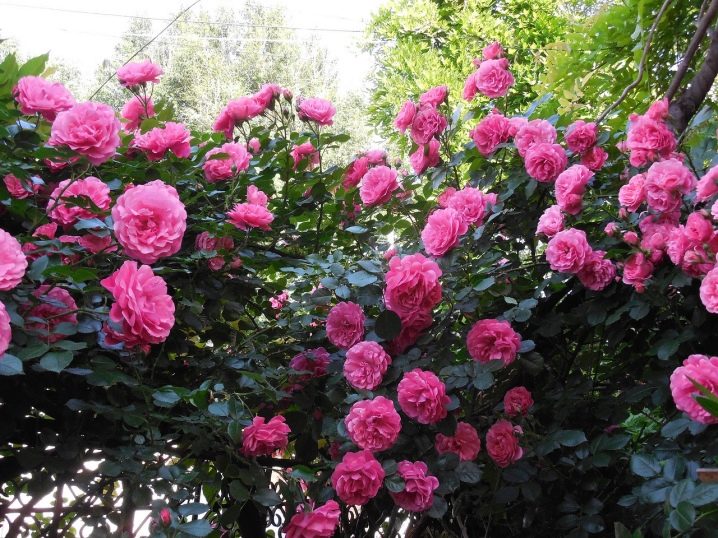
What it is?
Speaking of park roses, it should be noted right away that there are several subgroups of such plants.
There are three of them:
- cultivated species of rose hips;
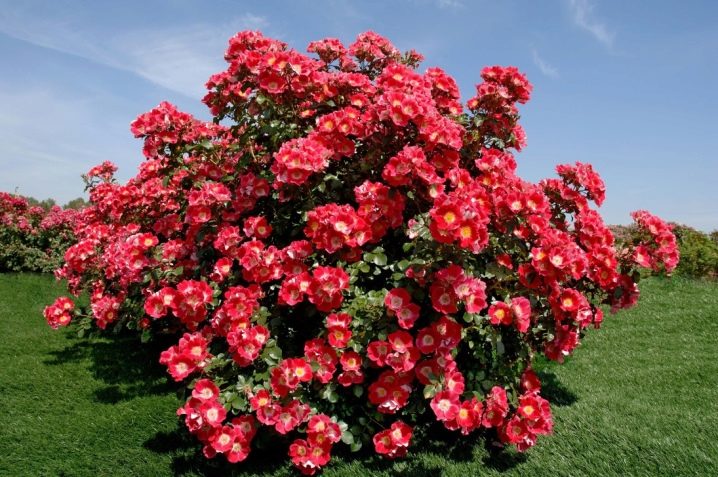
- antique roses;
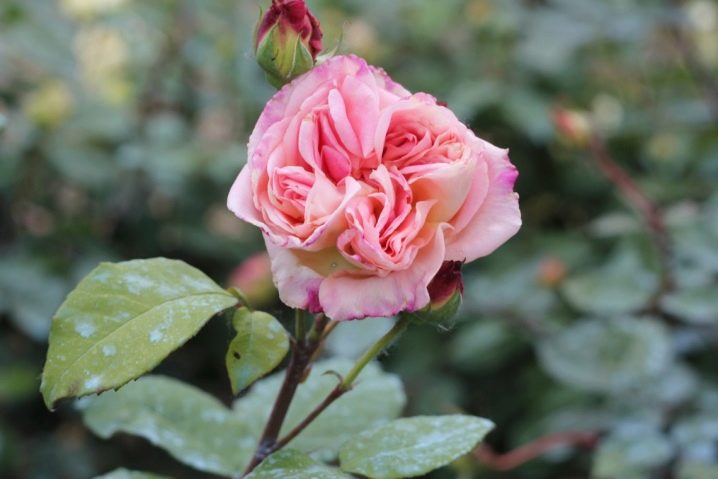
- hybrids bred by modern breeders.
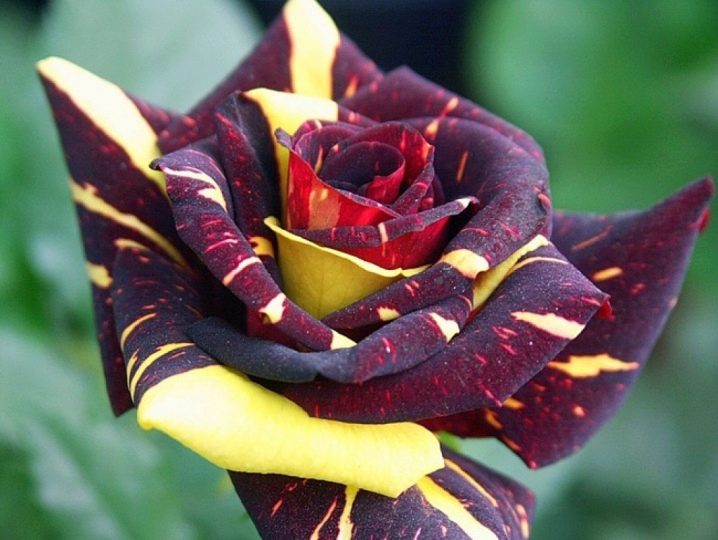
The plant itself is of medium height: the bush usually grows up to half a meter.
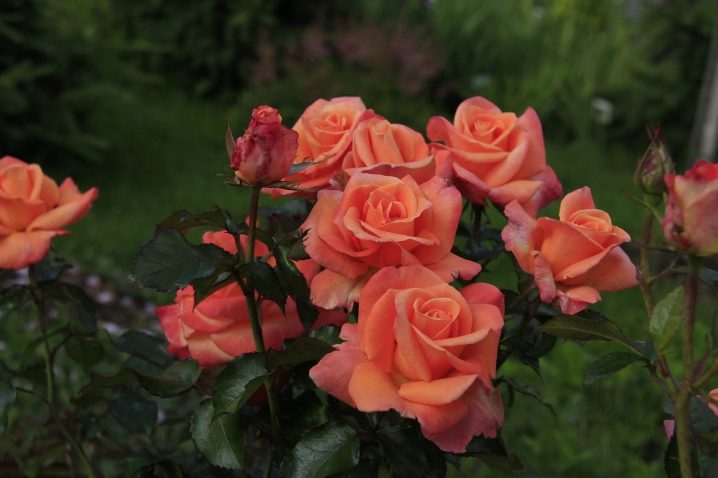
Park rose blooms early, and this process lasts up to a month, and in some varieties even longer. The color of the buds is very versatile: you can see both pale white flowers and specimens of deep purple color. To the touch, the bud is a little rough, terry, and the number of petals exceeds 100 pieces - no other variety of roses can boast of this.
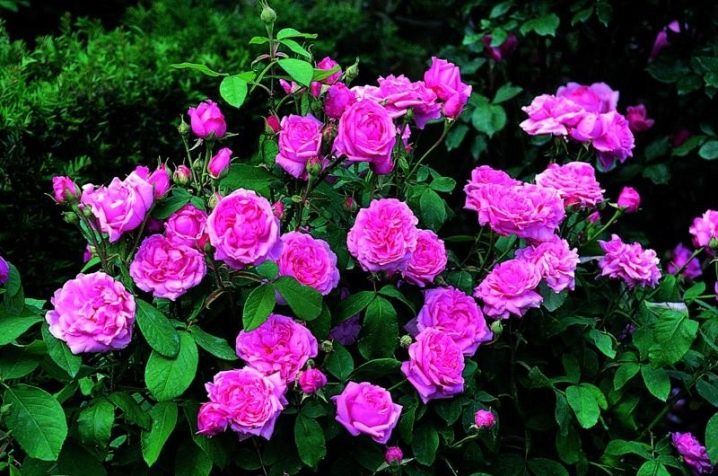
Park roses can also be roughly divided into two large groups:
- blooming once;
- blooming repeatedly.
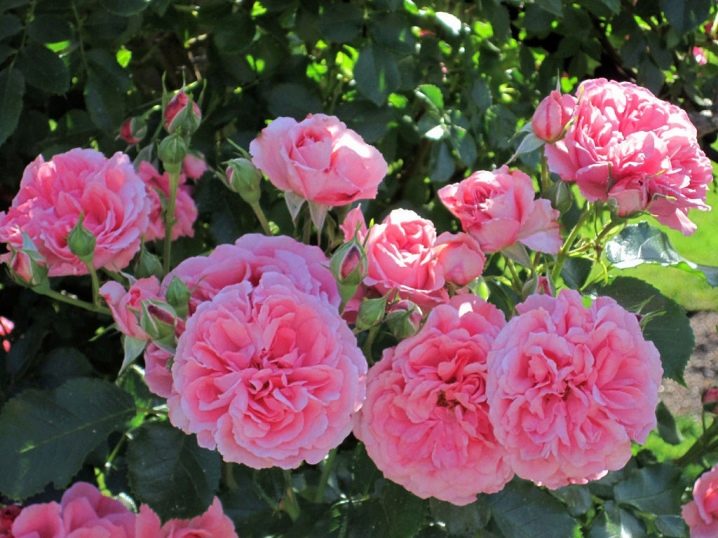
The first variety most often grows in private plots, where the gardener has the opportunity to renew the plant annually. However, here you need to take into account an important nuance: you cannot cut off last year's shoots: this will lead to the fact that flowering simply does not occur. But such roses are incredibly frost-resistant, some varieties can safely spend the winter without additional shelter. Re-blooming roses may not always boast such cold resistance benefits. Here, too, there are excellent varieties that can survive the winter without any special problems, but there are also those that require not only shelter, but also bending the branches.
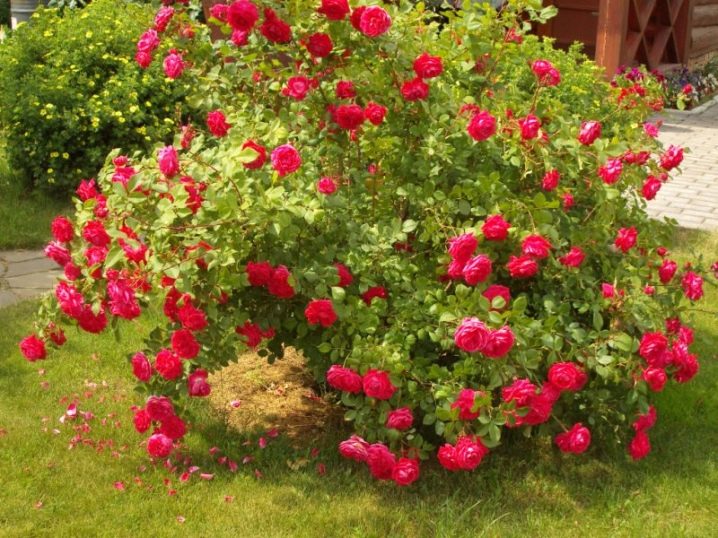
Consider the benefits of all park roses:
- long and beautiful flowering;
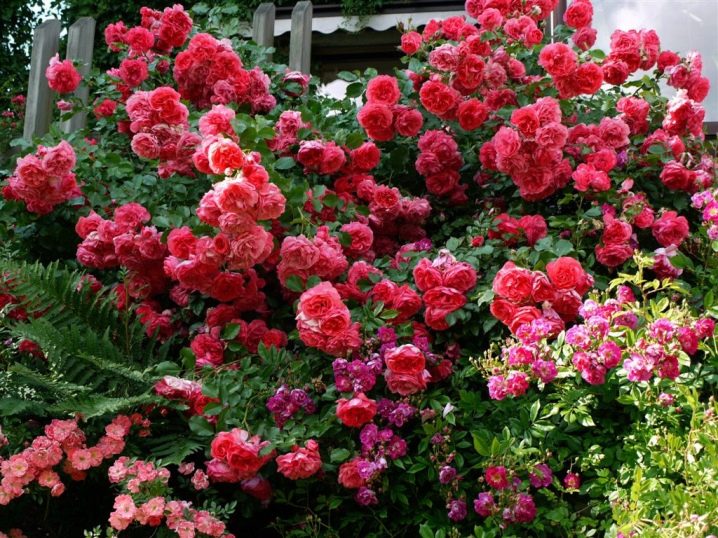
- excellent resistance of most varieties to Russian frosts;
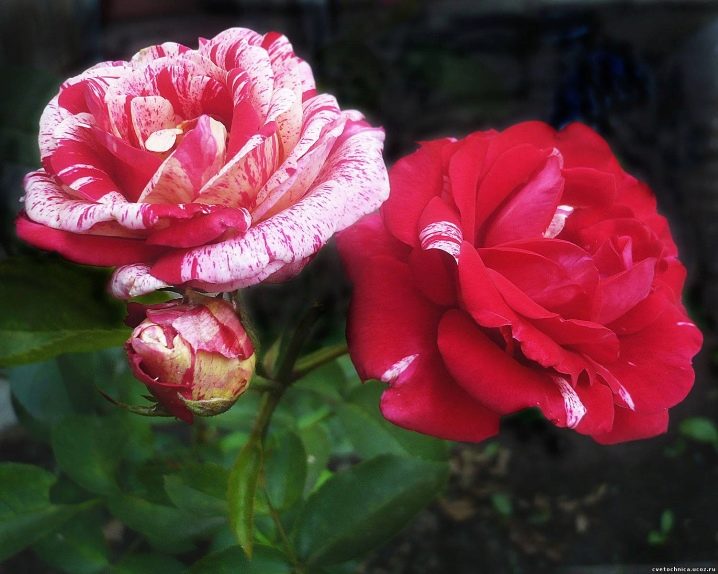
- the presence of an extensive assortment of species to choose from;
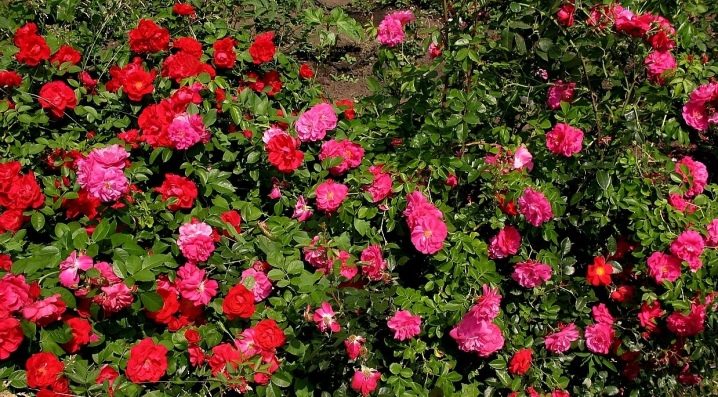
- the ability to decorate and revitalize any landscape design;
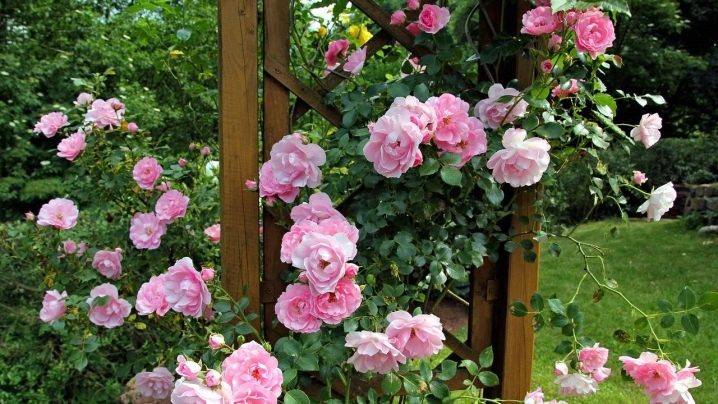
- good resistance to diseases and pests.
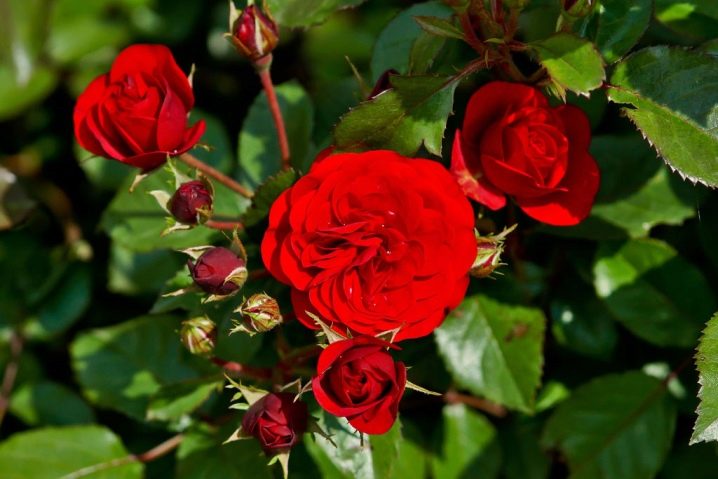
There are also several disadvantages that need to be considered:
- some varieties do not tolerate winter well if they are not prepared;

- the plant is demanding for proper watering and care;
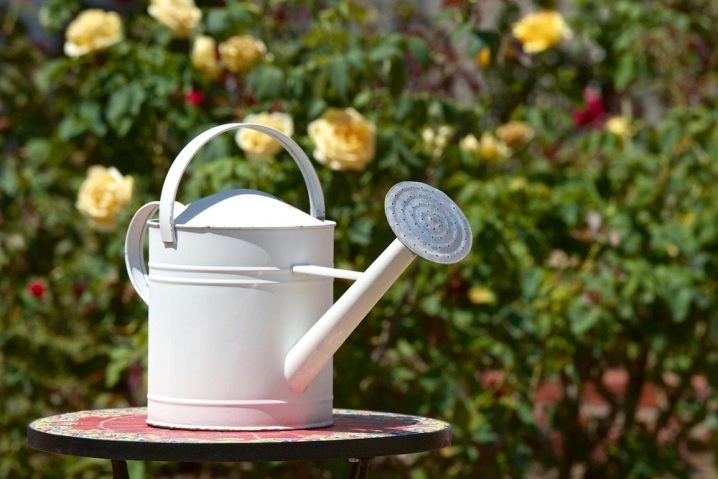
- every 4–5 years, it is necessary to divide the bushes.

Variety of varieties
There are a huge number of varieties of park roses, and it is not possible to consider all of them. Let's dwell on the description of the most popular subspecies of this plant.
- Havenly Pink. It is a musky rose up to 1.2 meters high. Differs in double pink flowers with a barely perceptible aroma. It blooms several times, it is resistant to all kinds of diseases. It can withstand frosts down to -25 °.
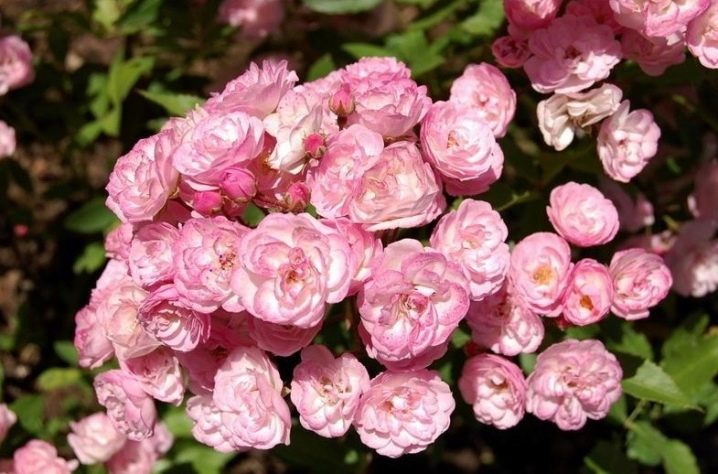
- "Commandan Baroper". It is one of the best varieties for the Moscow region, as it perfectly tolerates even severe frosts. The Komandana bush reaches a height of about one and a half meters, is characterized by the presence of bright foliage and light pink flowers with dark stripes. This variety is picky about soil and care, does not always tolerate diseases well.
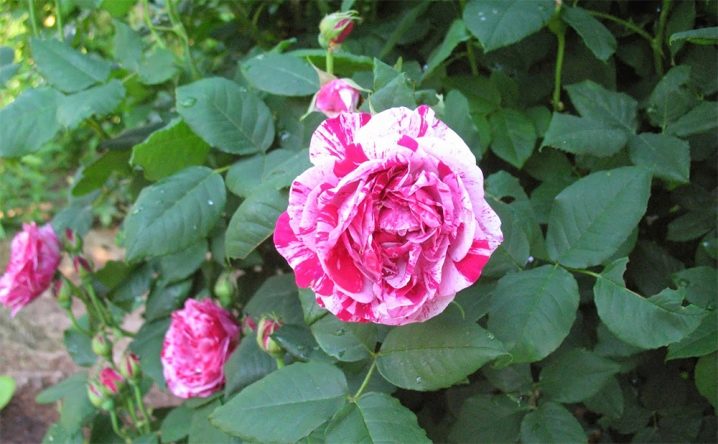
- Westerland. A rather tall rose, with good care it grows up to 2.5 m. It has incredible beauty orange buds with a strong aroma.The only drawback is fragile shoots that need to be tied up.
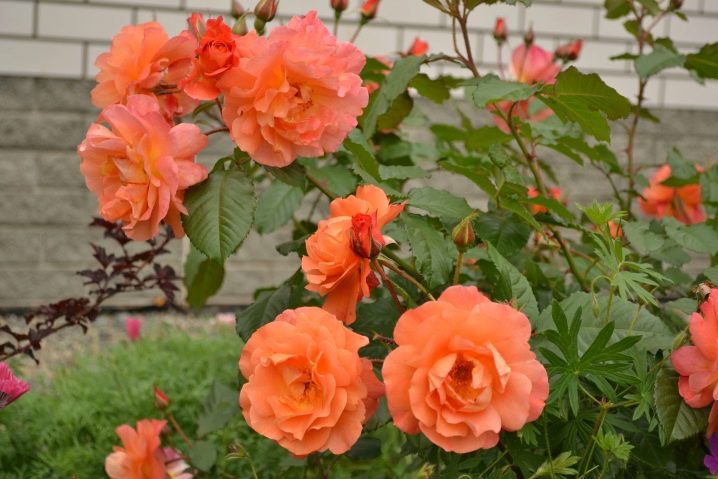
- Chinatown. Such a rose will perfectly take root in central Russia, but for the winter it is better to provide it with shelter. In spring and summer, the bush will delight you with creamy yellow flowers with a bright aroma. An interesting feature of the variety is that it can be planted even on poor soils.
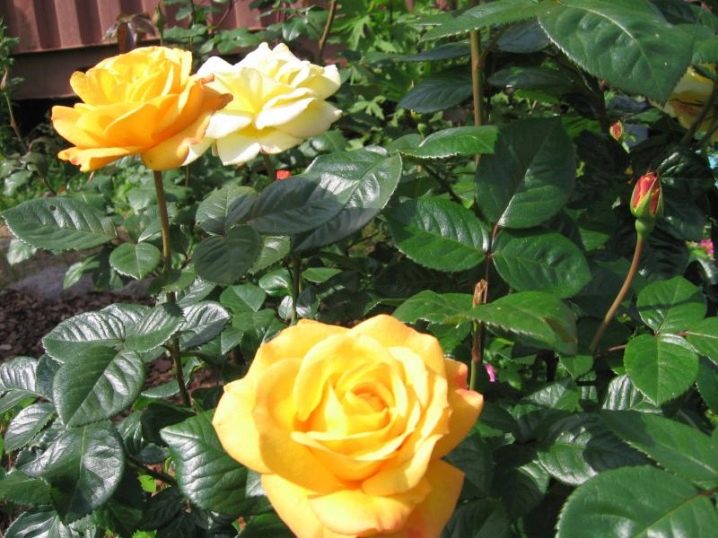
- Artemis. The variety, named after the ancient Greek goddess of the hunt, Artemis, embodied the features of an ancient warrior in the best possible way: its strength, inflexibility and grace can be envied. It blooms very profusely, during flowering you can see beautiful buds of a creamy white color. Shoots are tough, with many thorns. The aroma of flowers can hardly be called classic; rather, it contains notes of anise.
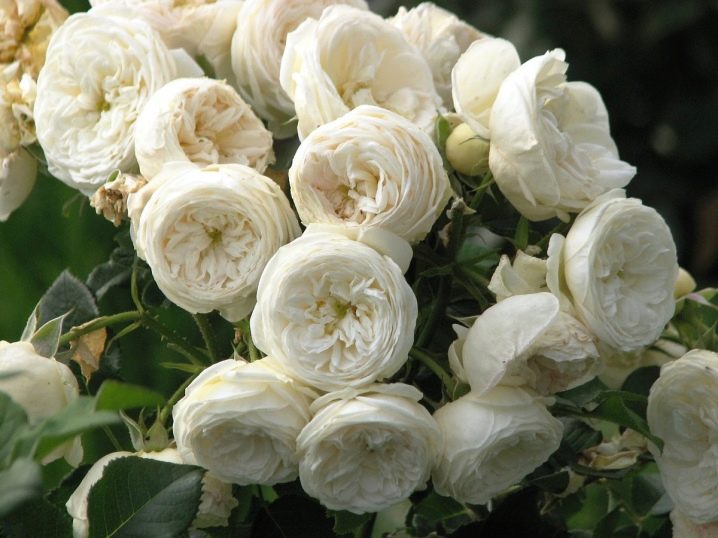
- Ferdinand Pichard. This is a variety that will bloom in summer and fall. Roses "Pichard" usually have a pale pink color, there are raspberry stains. The aroma is very intense. The peculiarity of the variety is that it does not have two identical buds, each is individual.
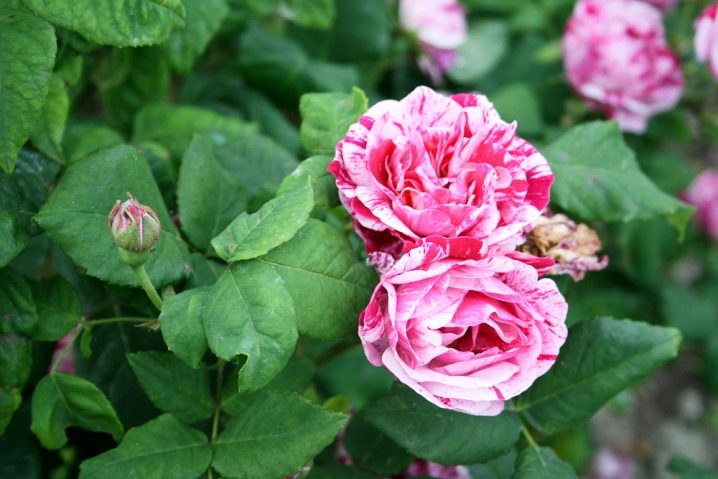
- Braze Cadfael. Roses with such an interesting name are incredibly large and look more like peonies. They have a pale pink hue, and their aroma is classic, pink. It is worth noting that this is one of the varieties that does not tolerate an abundance of moisture.
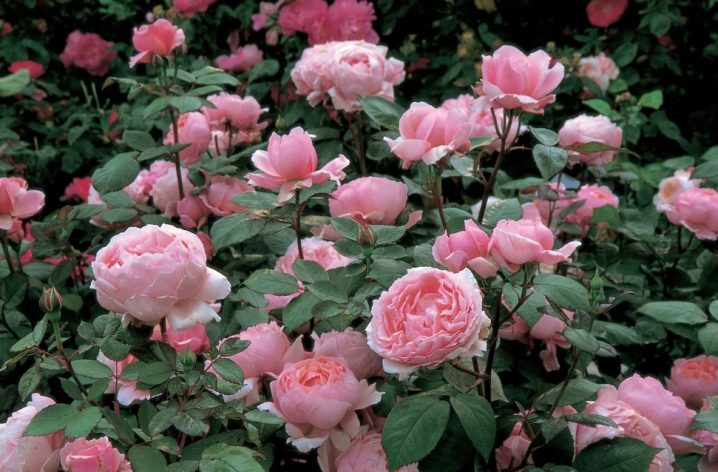
- Ruban Rouge. Ruban Rouge roses have bright red buds and an intense scent of wild berries. Bushy shrub, very resistant to pests. Flowers of this variety stand well after cutting.
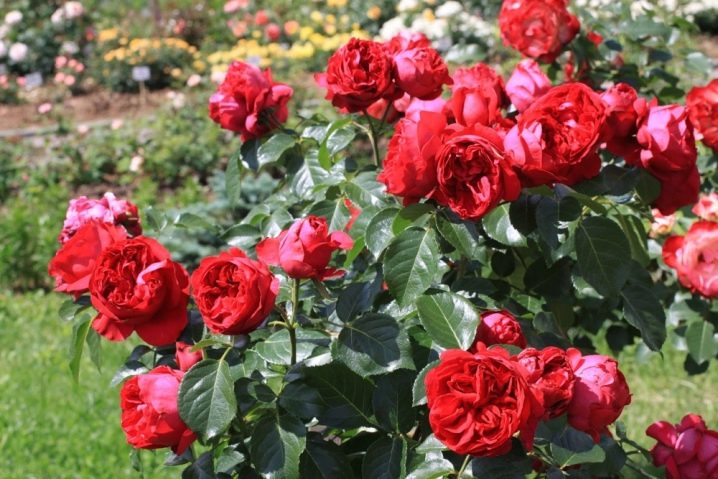
- Dieter Müller. A classic, modest variety that evokes memories of the residences of English kings. The flowers are pink with a lilac tint, have a pronounced aroma of rose and spices.

- Alexander Mackenzie. This is a rose that was named after the researcher of the same name. It is very noble, has bright red flowers, dense tight foliage and stems. The aroma is reminiscent of strawberry.
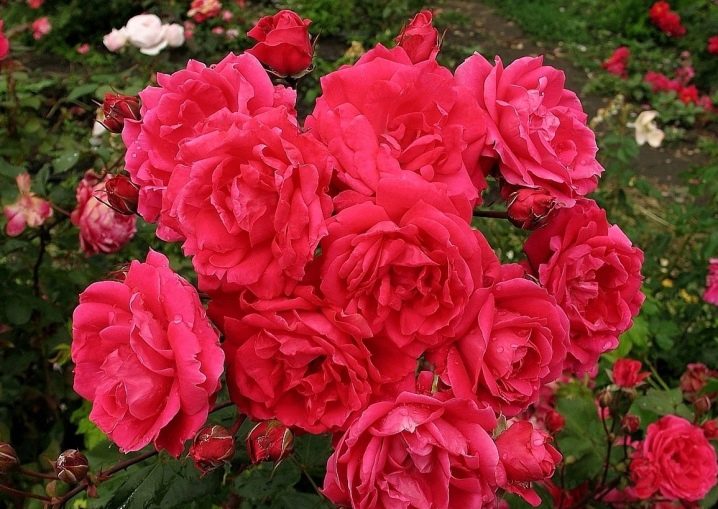
- John Franklin. The buds of this variety are distinguished by an unusually carmine-red hue, pointed at the tips. Suitable for growing in harsh regions, but needs careful maintenance.
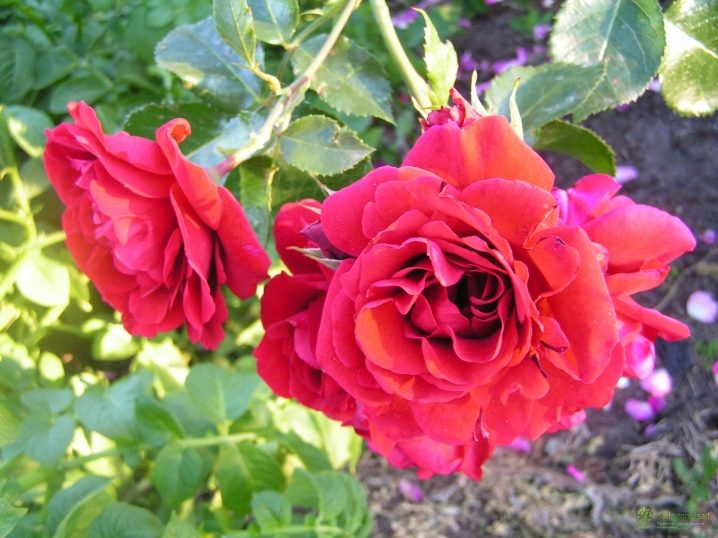
- J.P. Connell. A very interesting variety, one of the few yellow ones. There are red stamens in the center, and the bud itself quickly fade in the sun and becomes creamy. The disadvantage of this type is its low resistance to black spot.

Planting and care rules
Before you start planting a rose, you need to prepare the correct area for its growth. The sun is very important for such plants, therefore they are planted in spacious, well-ventilated and well-lit areas. Avoid placing trees nearby that will cast a shadow. In the shade, roses also bloom, but this will be a weak and rather short flowering.
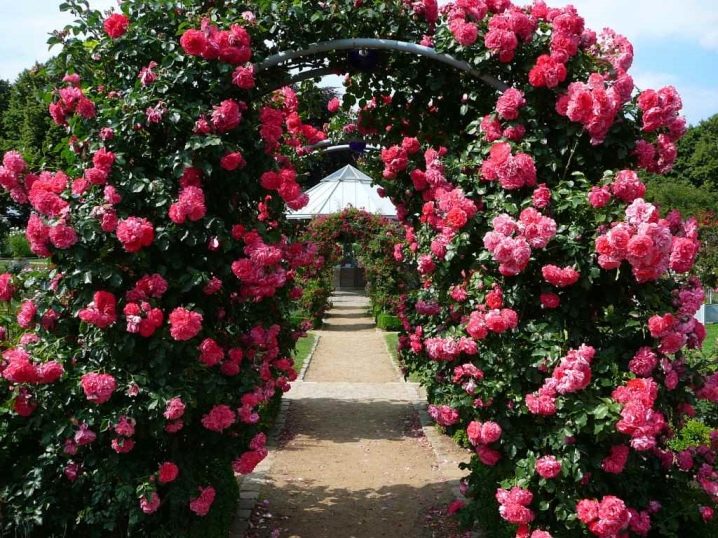
As for the soil, here the park rose is not too pretentious. But if you want the plant to root quickly and gain strength, you need loose earth. Light soils are mixed with manure, but peat is recommended to be added to heavy ones.

If you neglect this rule and leave the soil too clayey, water will begin to accumulate in it, which can lead to the spread of the fungus.

The optimal time for planting a park rose is early September. It is this period that will help the plant to adapt sufficiently before the cold comes. Plants are planted in whole groups, but if you want to plant roses one by one, this is also acceptable. Consider how best to land.
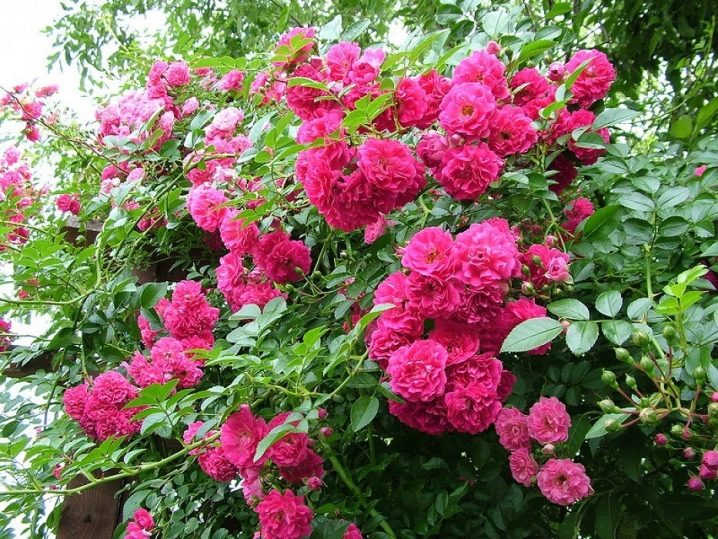
- The first thing to do is to dig the planting holes. The diameter of such a hole, as a rule, is about 50-60 cm, the depth is 0.5 m. The earth can be supplemented with a small amount of humus and wood ash: this will help the roses bloom more abundantly and more beautifully.
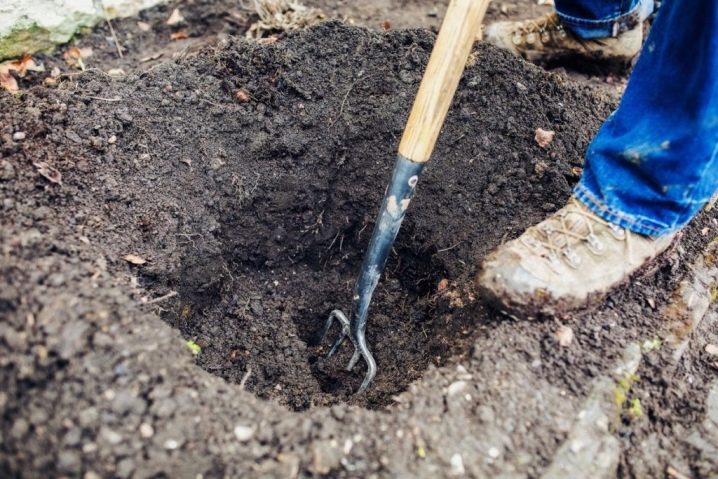
- For seedlings with closed and open roots, the planting scheme is somewhat different. If the roots are covered, just place the sprout in the hole and sprinkle the soil on top.If the root system is bare, you should pay more attention to the seedling. First, the roots are examined. If there are signs of disease, decay or damage, the infected specimens are removed. A small earthen embankment is made inside the hole, a seedling is "planted" on it, the roots are straightened and sprinkled with soil.


- Each bush is well watered: one rose will need 10 liters of water.
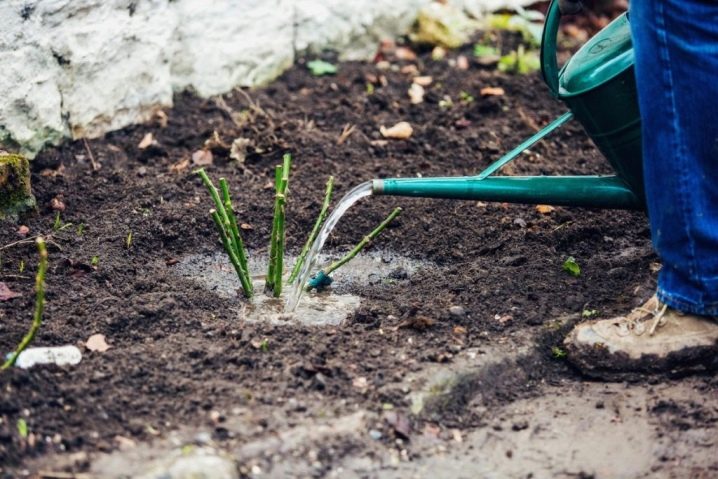
- When watering is over, the soil is mulched. This will help the liquid to feed the bush for some time and delay the development of pathogens.

Not only proper planting, but also timely care will help the bush to develop and bloom profusely.
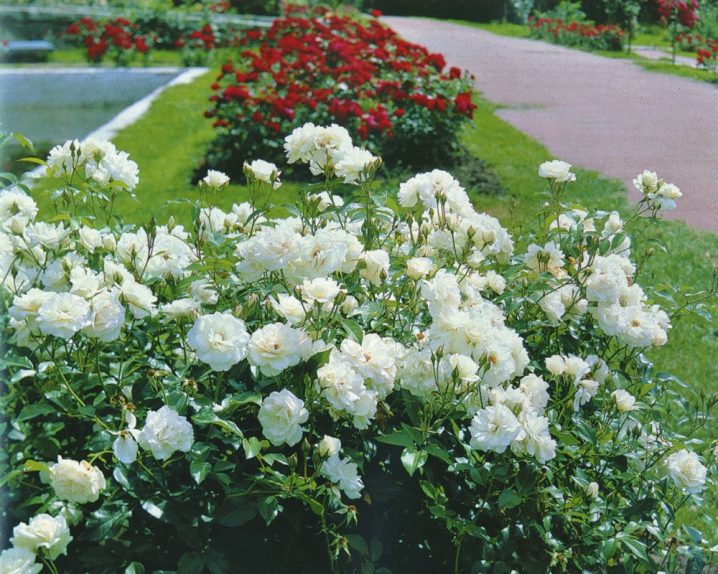
One of the most important steps in care is watering. It is important to consider the type of soil. If these are sandy lands, then they dry out quite quickly, and the frequency of watering will have to be increased. If the earth is clayey, on the contrary, it will hold water for a long time. In hot and dry weather, roses are watered daily; on cloudy days, the amount of water supply can be limited to 3 times a week. Pay attention to the wind: the stronger it is, the more water you need to give the plant. There have been cases when the bushes dry out in strong winds, even having received a large amount of liquid.
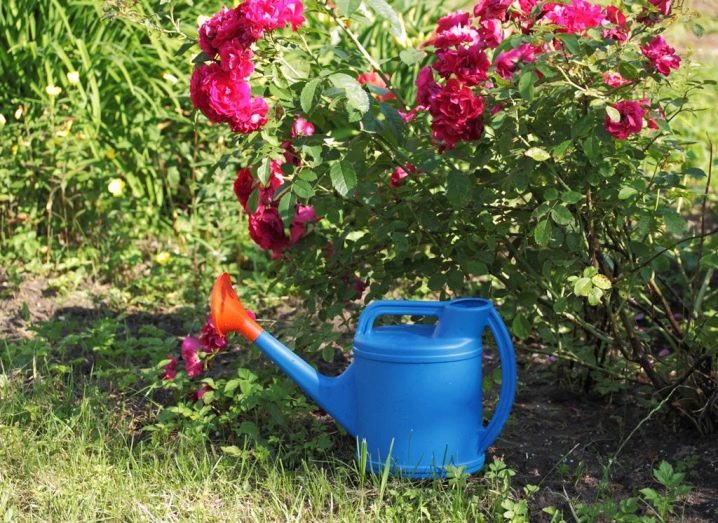
It is better to water park roses in the morning, until the weather clears up too much. Thanks to this simple technique, you can protect the leaves from burns, and at the same time from many diseases. A large watering can or hose is used for watering. Even if you have an irrigation system, experts recommend at least occasionally watering the roses with a hose. Strong pressure destroys the spider mite, which is one of the most annoying pests in the garden and vegetable garden.
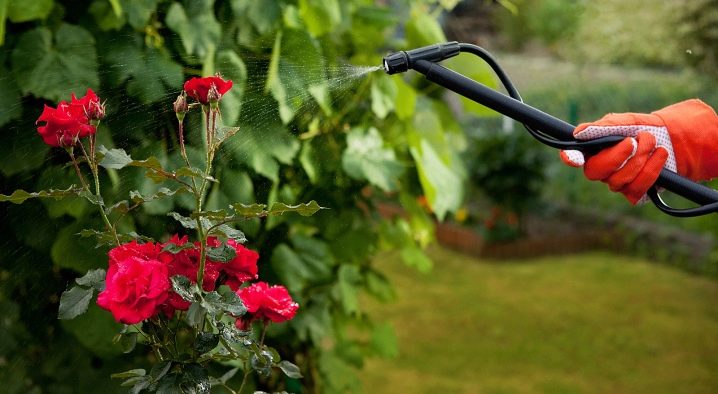
The second point of care that should be taken into account is timely pruning. However, you should not be too zealous here: it is important to remove only those shoots that have become too old, rotten, and sick. Pruning is carried out and at the end of flowering, only faded buds are removed instead of shoots. They stop pruning at the very end of summer: before September.
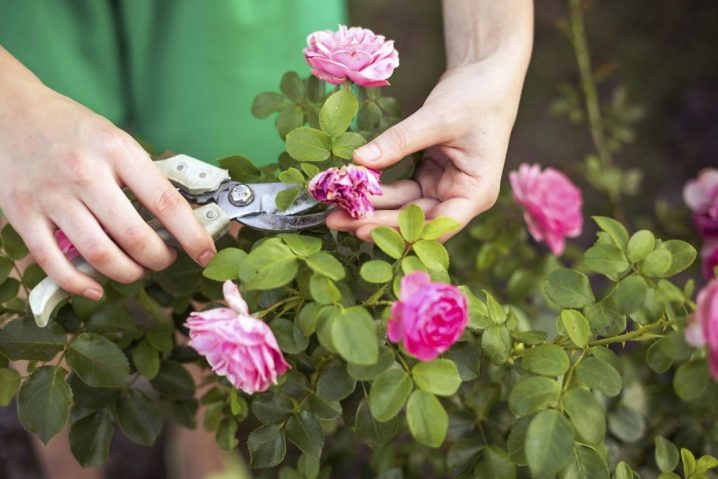
Before the cold weather begins, most varieties of roses must be covered for the winter. To do this, you need to remove the leaves from the shoots, bend them and attach them to the ground. Some adult bushes with a developed root system can be quite problematic to bend, since there is a risk of breaking the trunk. But here, too, there is a solution: dig it up a bit and start bending the root slowly. When the root gives in, the plant can be completely bent down. Then the park rose is covered. For this purpose, spruce branches are usually used.

It is worth noting that frost-resistant varieties can not be bent down - in this case, the branches of the bush are simply wrapped in craft paper and made a small, 20 cm, embankment in the root zone.

Top dressing and reproduction
The first year after planting the rose, you do not need to fertilize, since the plant will feed on nutrients from the soil itself. But in the second year, it is recommended to start a little feeding. At the beginning of spring, it is very important to make up for the lack of magnesium and iron. For this, complex fertilizers for roses are suitable, which can be purchased at a gardening store. In addition, it is a good idea to add organic matter: humus or manure.
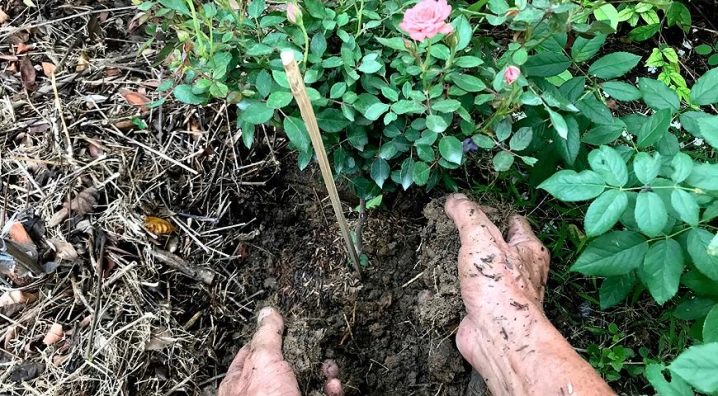
The next feeding is done at the end of August. It is she who will allow to strengthen the roots and prepare the plant for cold weather. Be sure to add elements such as calcium, phosphorus, potassium. The September top dressing also contains potassium, but it must also contain phosphate. All this in equal proportions (15 g each) is diluted in 10 liters of water, and then the roses are watered. The last fertilization is in October, with organic components being the most appropriate.

You can propagate park roses in one of four ways.
- Division. For this, they choose the beginning of March, when the first snows have already melted, or early autumn. Separate stems are cut with pruning shears, which must necessarily have a root. Landing is done according to the classical technique.
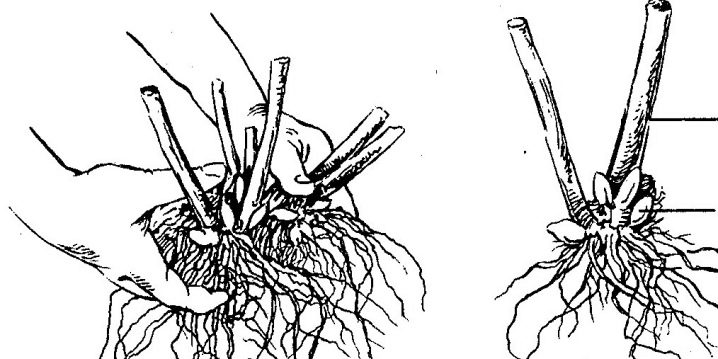
- Cuttings. Cuttings with fresh bark are taken in the fall. For the winter they are buried in the sand, while in the spring it is time to disembark. Green cuttings are planted when flowering begins.

- Layers. This is the most durable breeding method. To achieve the result, the rose bushes are bent down, fixed, and earth is poured on top. By next year, new seedlings will be ready, which will need to be separated from the mother bush.
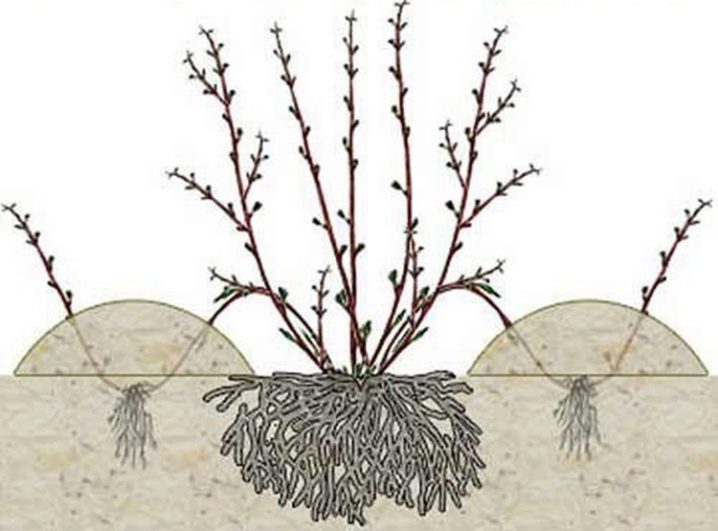
- Overgrowth. In this case, they are waiting for the bush to be one year old, and in the spring, the branches are separated from it. They will need to be trimmed a little: by about a third, and then you can plant.

Diseases and pests
Despite the fact that park roses are quite resistant to many diseases and pests, the plant can still get sick. One of the most common plagues is powdery mildew. It develops especially actively in humid, foggy and wet weather, therefore, if the summer turned out to be just like that, it is recommended to start taking preventive measures in advance. The disease is characterized by the appearance of a whitish plaque. At first, it is located on the lower part of the foliage, gradually moving upward and filling the entire bush.
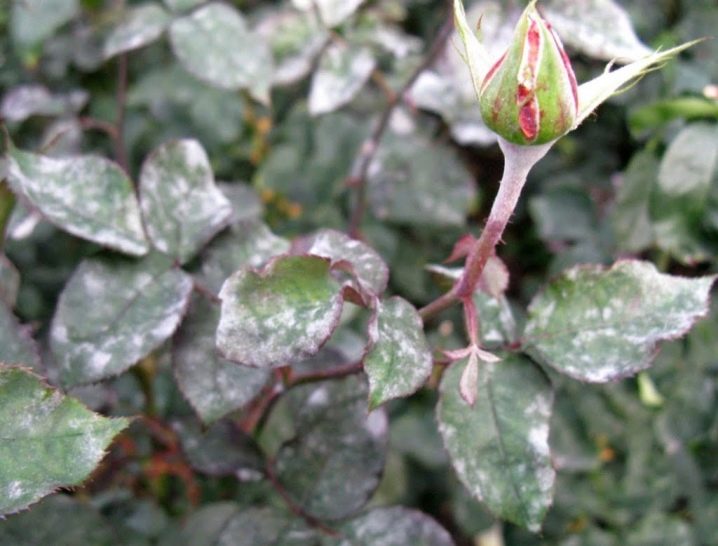
If nothing is done, the plant will quickly decay and become unusable. This ailment is especially dangerous for young, newly planted plants.
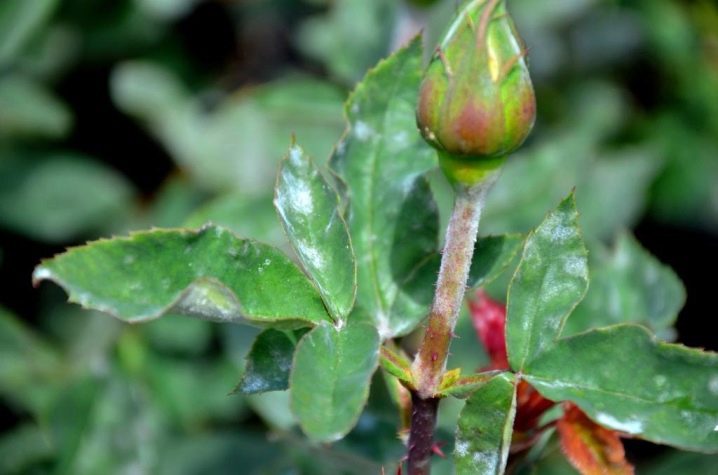
As soon as powdery mildew has been detected, all shoots and leaves that are affected by it should be immediately removed. They need to be burned, and preferably away from your site. Then the remaining plants are treated with a 3% solution of Bordeaux liquid. Nettle broth also helps very well. In addition, 1 kg of soap and 0.5 kg of vitriol can be dissolved in a bucket of water. Such a solution will thicken quickly, so it can be slightly warmed up before use.
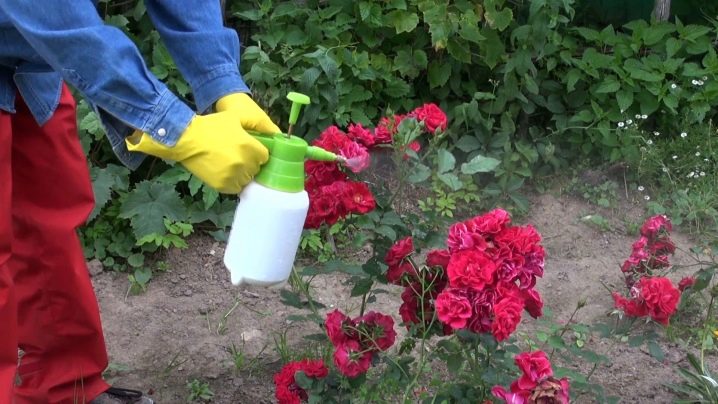
The second disease that plagues park roses for several years is gray rot. It is also caused by high humidity, as well as late evening watering, which provokes moisture stagnation. The disease manifests itself with a gray fluff that occurs on any part of the plant. There is no need to wait for any flowering with this ailment, since the ovaries and buds are also affected.
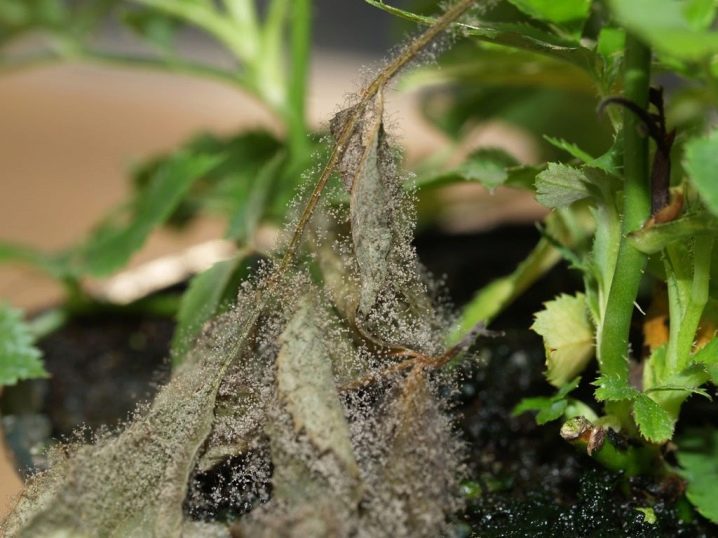
Another fungal disease that often progresses on park roses is rust. The disease develops especially actively in late spring. In this case, red pimples appear on the foliage and stems, and empty bubbles appear on the lower part, which become a focus of infection for other plants. As a treatment, all diseased shoots are first removed, and then 2% Bordeaux liquid is used. It is rather difficult to cure such an attack, but it is possible to prevent it. To do this, feed your roses with manganese fertilizers from time to time. As in the previous case, diseased plant parts should be removed in a timely manner.
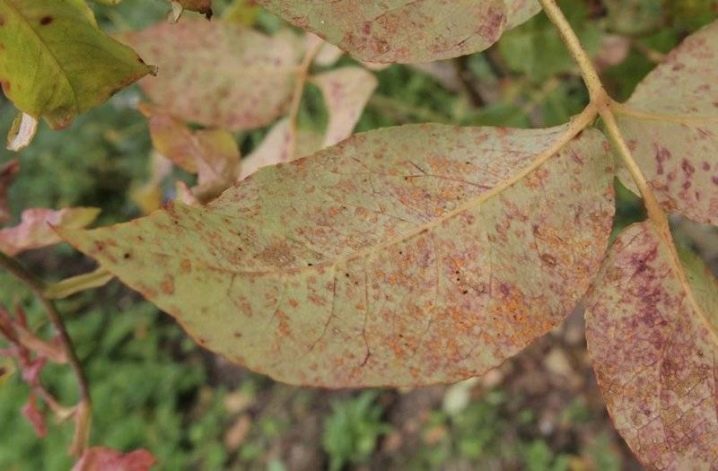
Of the pests, the spider mite does great harm. This tiny insect, practically invisible to the eye, creates whole thickets of cobwebs, due to which the leaves turn yellow and die off. The spider mite is well washed off by streams of water, but strong insecticides will be the best means of killing it. In this case, all leaves affected by insects must be cut off and burned. In addition, roses are often attacked by the crimson weevil. This pest feeds on plant juices, constantly gnawing stems and foliage. Weevil larvae live in buds and also gradually gnaw them, preventing them from blooming. They fight weevils with the help of insecticides, and simply picking beetles by hand also helps.

Aphids are another insect that all gardeners know firsthand. Aphids attack not only roses, they parasitize absolutely any plant, quickly rendering it unusable. The first sign of aphids is strange, shiny tracks on the foliage, as well as an increasing number of ants. You can fight aphids both with insecticides and folk methods. Soap solutions, spraying with infusion of young garlic help well.An additional measure of control is the attraction of ladybirds. These garden protectors are effective against aphids and the population will gradually decline.
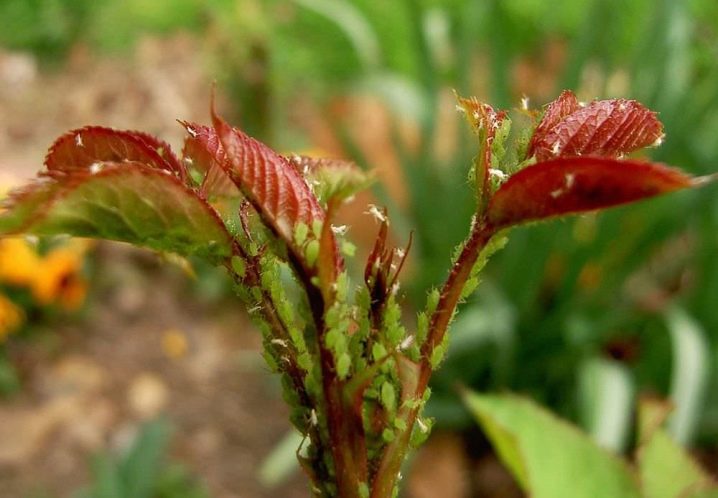
It is quite difficult to destroy such an insect as a bear. This is a real predator that prefers to live underground; on the surface, a bear can rarely be found.
The pest feeds on roots, fresh flower bulbs, eats seeds. Plowing the ground before planting will reduce the harm from the bear. You can loosen it after planting roses, but be careful not to damage the roots. Such plowing deforms the underground tunnels of the pest, spoiling their eggs. In addition, it would be a good idea to land next to the roses of marigolds: these unobtrusive flowers will completely discourage the bear from living on this site.
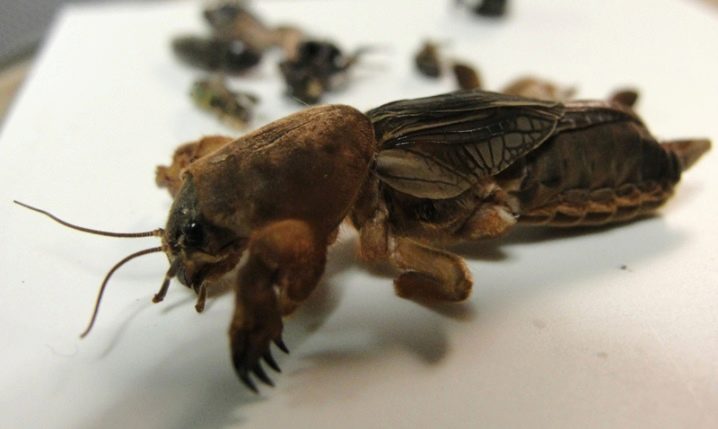
Consider a few tips from experienced gardeners that will help you avoid most of the above diseases:
- carefully monitor the condition of the site, remove weeds, loosen the ground from time to time;

- do not water roses in the afternoon and late evening, the best time to supply water is early morning;

- do not forget about dressings: the more balanced they are, the less the risk that the rose will catch the disease;
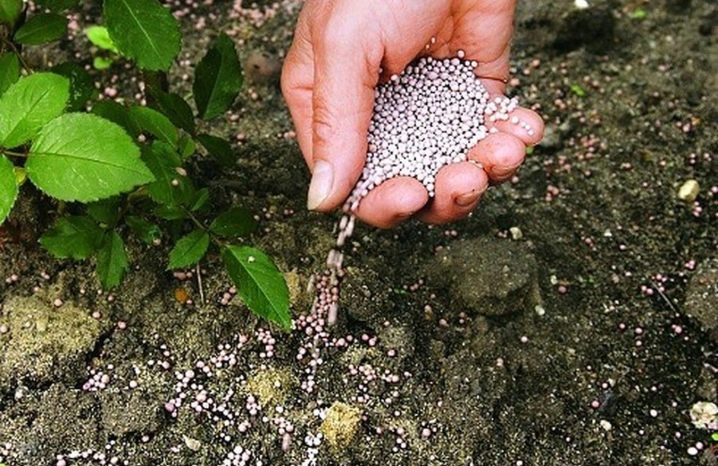
- do not plant roses in close groups, avoid thickening of plantings: in places where there is little light, excellent living conditions are created for many parasites;
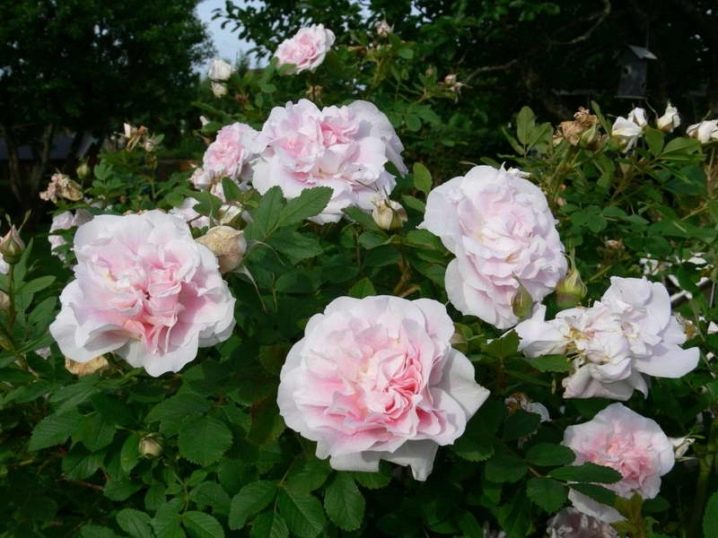
- prepare the soil before planting: it is important that the plant is protected from bacteria for as long as possible.

Use in modern landscape design
Park roses are most often used to decorate and beautify areas, and there are several reasons for this:
- most varieties are winter hardy;
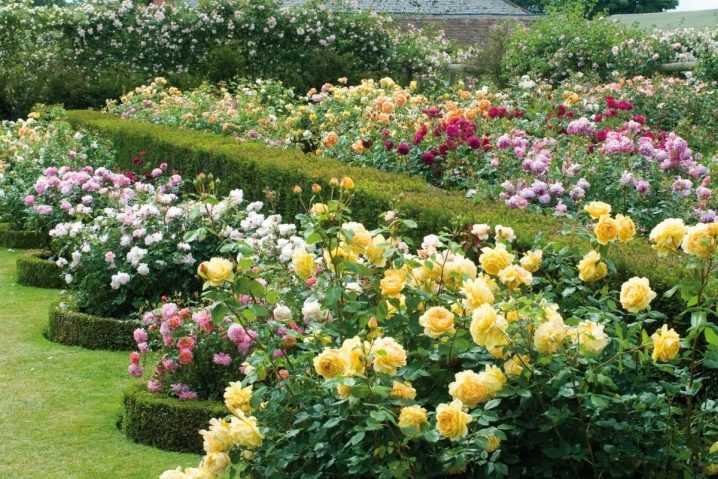
- park roses have a double surface, which is pleasant to look at and touch;
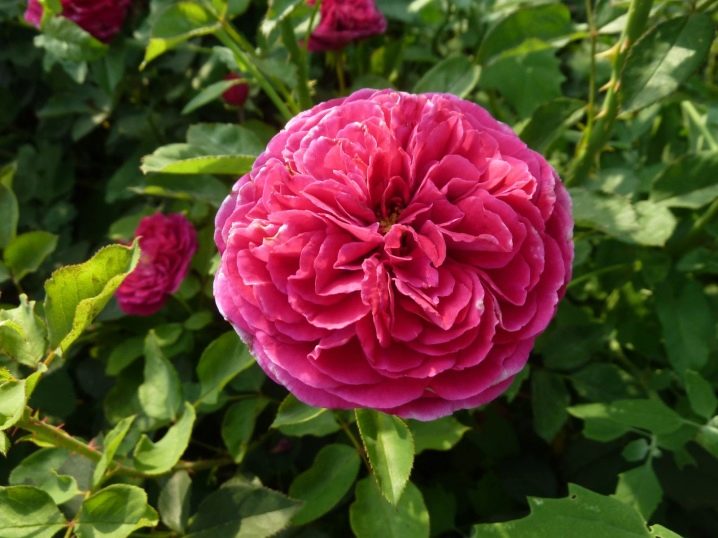
- a huge number of colors allows you to create almost any ensemble;
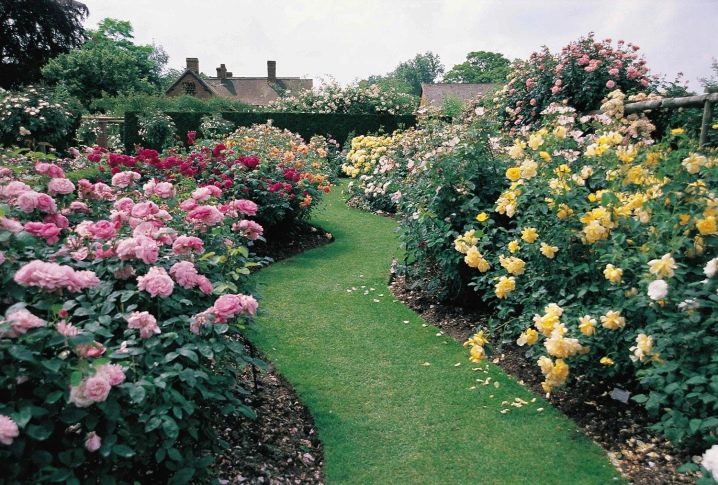
- roses go well with other flowers.
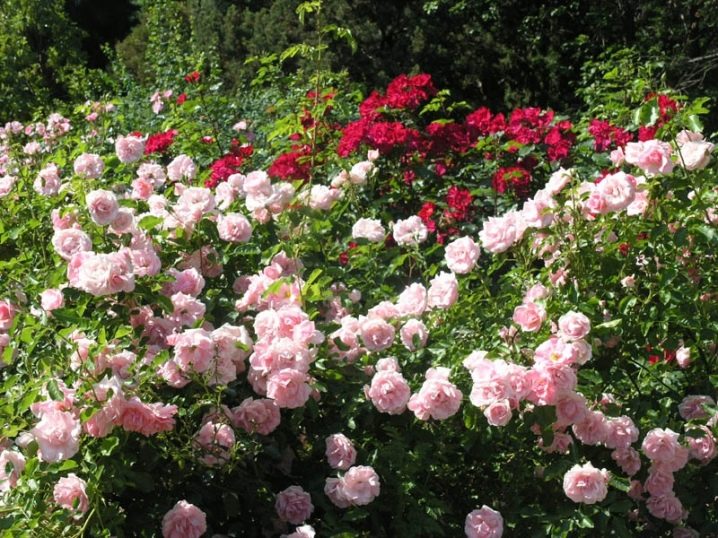
These plants look great in groups and singly. For example, they can be planted around the perimeter of the house, and then the building will sparkle with new colors. At the same time, roses of bright shades look especially beautiful: red, purple, pink. In addition, park roses are perfect for decorating paths: if you plant compositions of such flowers along the edges of the path, you will get the impression that you are in a beautiful landscaped park.
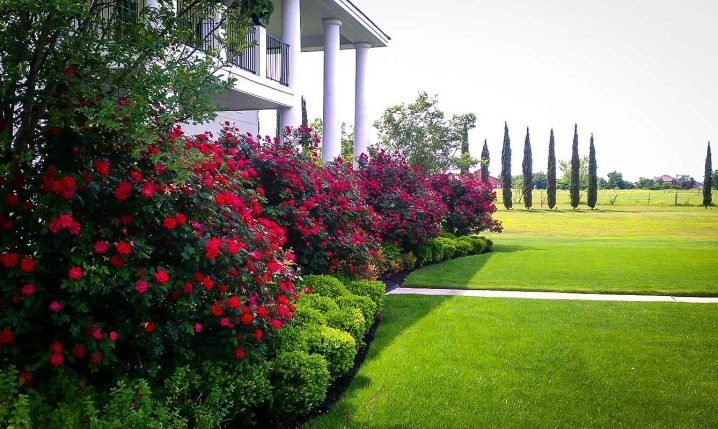
Another technique can be used to ennoble the gardens of country houses: create a small compositional rose garden, where the plants will be in the center of the circle.
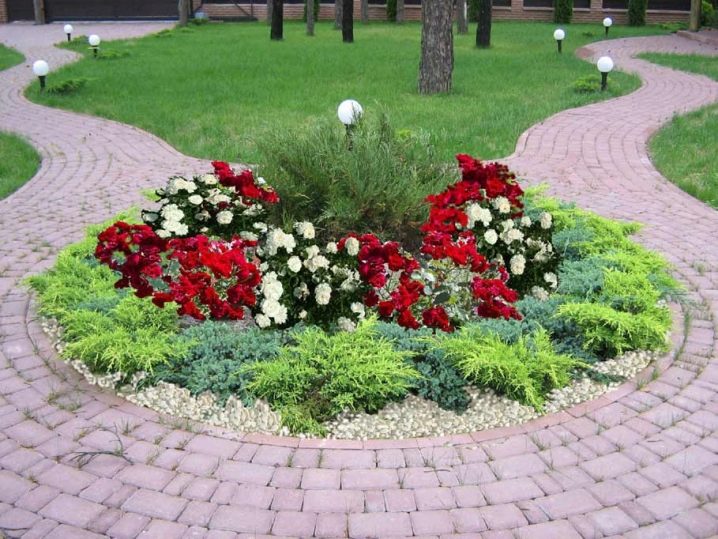
Creating a hedge of park roses would also be a great idea. Such a hedge will turn a garden or courtyard into a romantic place, and it will also be good at absorbing sounds from neighbors. To make such a hedge, you need to choose strong varieties with well-bending shoots. In addition, the variety must be very disease resistant, otherwise the hedge will have to be removed completely. Plants are planted, as a rule, in a checkerboard pattern. In this case, it is worth choosing cultivated rose hips: they are ideal for such plans.
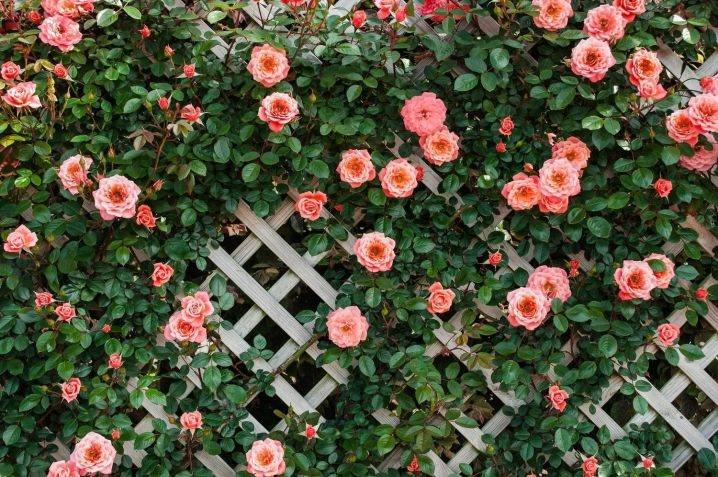
For vertical placement, you need liana-like roses. They come with small and large flowers. The first option will be appropriate for complex supports, and the option with large buds will perfectly take root on simple straight trellises. Rose-entwined arches that greet you and your guests at the entrance to the garden look incredibly elegant, as well as compositions of several arches along the garden path.

You can also use a park rose as a solitary planting. This is the name of a single plant, designed to become a bright spot and accent of the entire composition. It is very good to place such specimens in the center of the garden, at the bottom of the stairs, on the slope of an alpine slide. If your possessions are large, it is not forbidden to place a whole group of identical roses in them. For this, low varieties of plants are used.
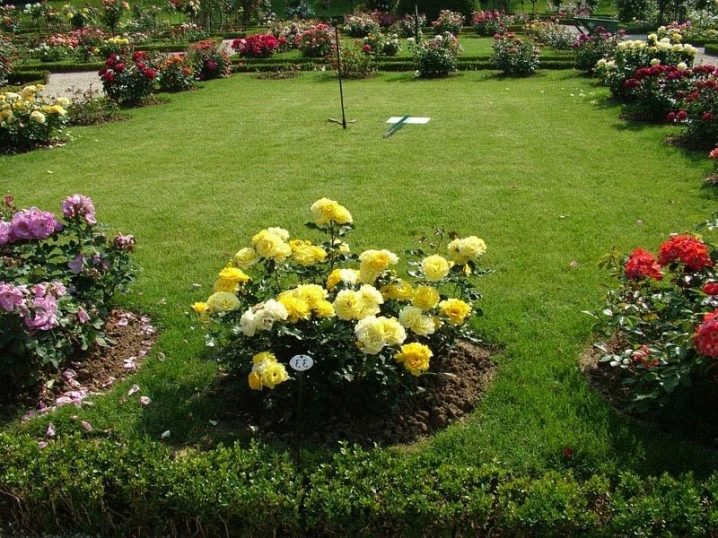
When it comes to combining park roses with other flowers, there are several key features here, which it is advisable to familiarize with novice gardeners:
- when choosing companions, give preference to varieties that have soil and care requirements similar to roses;
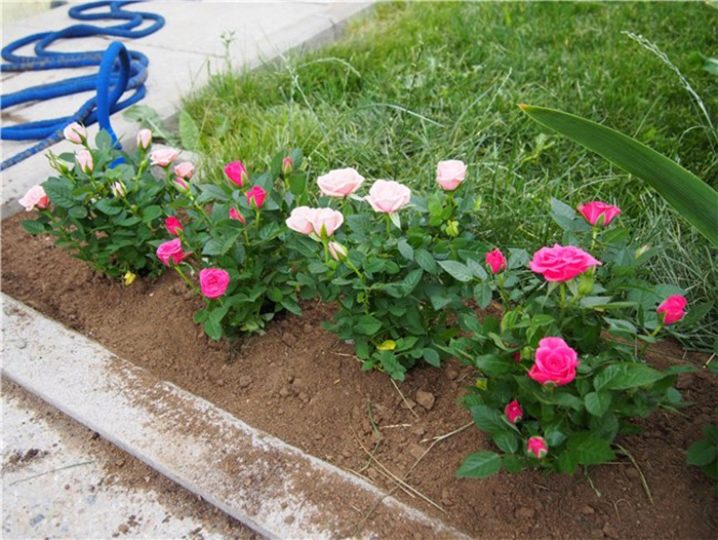
- you should not plant nearby plants that quickly fade and lose their original appearance;
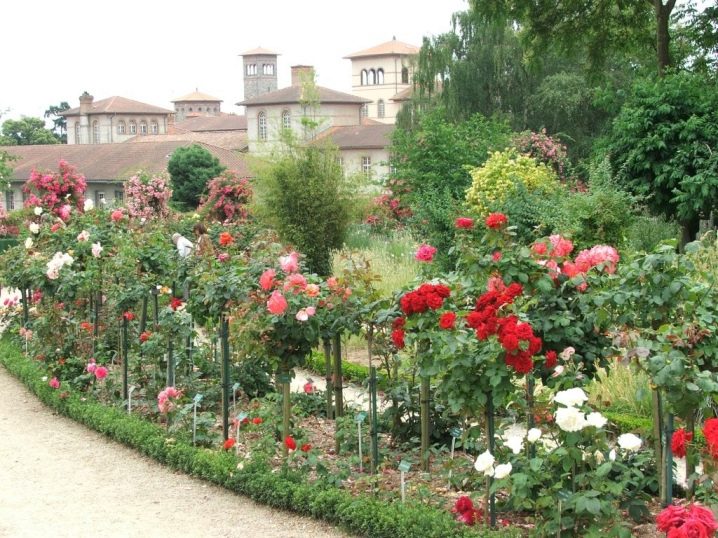
- be sure to pay attention to the height of other plants: if they are too high, they will shade light-loving roses, and if they are too low, then they simply will not be visible behind the queen of flowers;
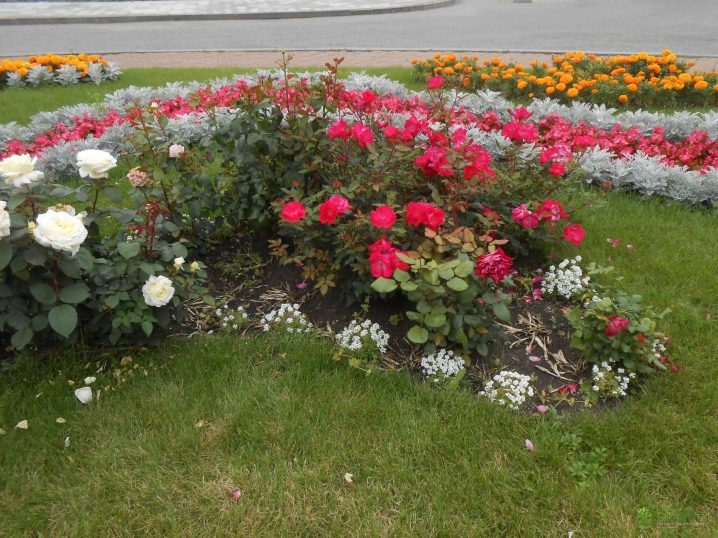
- it is very important to give the rose primacy, so there should be no flowers nearby that have too bright, saturated tones or aromas.
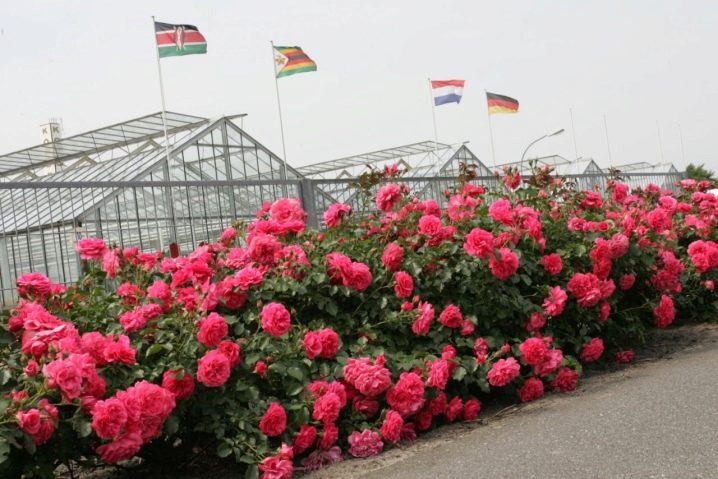
There are not so many rules proposed by specialists, which means that any gardener will be able to create beautiful compositions from roses and many other plants with his own hands. It is worth noting that classic ensembles are ideally complemented by perennial flowers. This emphasizes the elegance and restraint of the garden, gives it airiness and lightness. And so that your garden is not empty in anticipation of blooming roses, you should add early plants to it, and then it will sparkle with new colors.
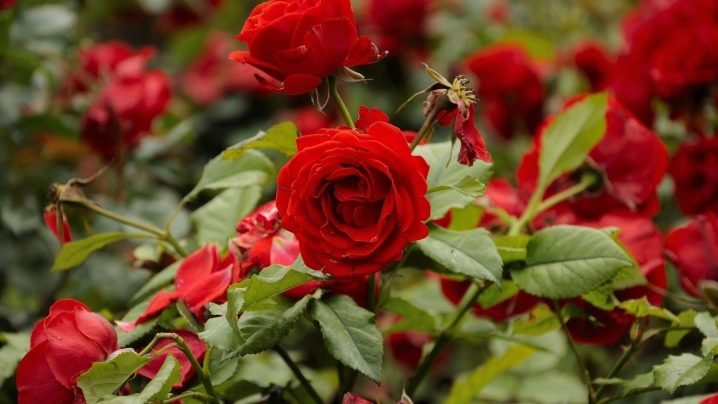
For more information on park roses, see the video below.


























































































The comment was sent successfully.